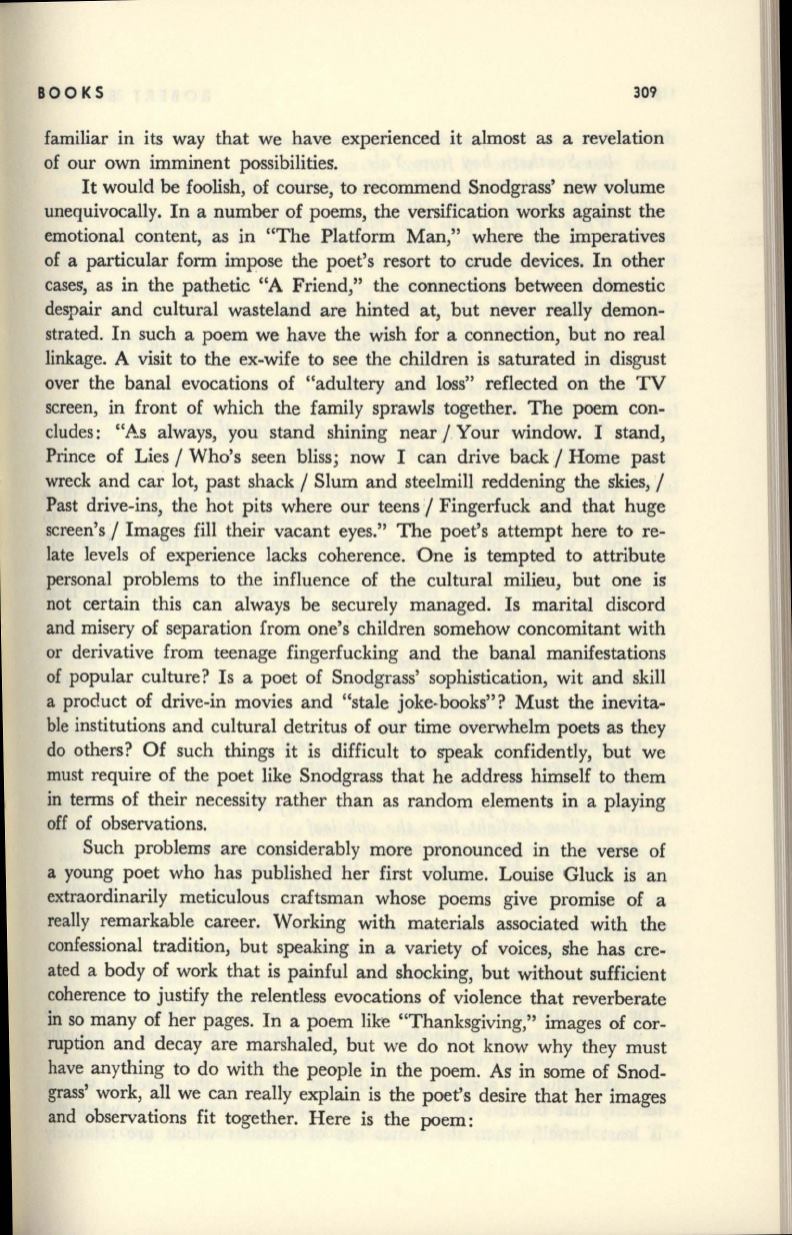
BOOKS
309
familiar in its way that we have experienced it almost as a revelation
of our own imminent possibilities.
It would be foolish, of course, to recommend Snodgrass' new volume
unequivocally. In a number of poems, the versification works against the
emotional content, as in "The Platform Man," where the imperatives
of a particular form impose the poet's resort to crude devices. In other
cases, as in the pathetic "A Friend," the connections between domestic
despair and cultural wasteland are hinted at, but never really demon–
strated. In such a poem we have the wish for a connection, but no real
linkage. A visit to the ex-wife to see the children is saturated in disgust
over the banal evocations of "adultery and loss" reflected on the TV
screen, in front of which the family sprawls together. The poem con–
cludes: "As always, you stand shining near
j
Your window. I stand,
Prince of Lies / Who's seen bliss; now I can drive
backj
Home past
wreck and car lot, past shack / Slum and steelmill reddening the skies, /
Past drive-ins, the hot pits where our teens / Fingerfuck and that huge
screen's / Images fill their vacant eyes." The poet's attempt here to re–
late levels of experience lacks coherence. One is tempted to attribute
personal problems to the influence of the cultural milieu, but one is
not certain this can always be securely managed. Is marital discord
and misery of separation from one's children somehow concomitant with
or derivative from teenage fingerfucking and the banal manifestations
of popular culture? Is a poet of Snodgrass' sophistication, wit and skill
a product of drive-in movies and "stale joke-books"? Must the inevita–
ble institutions and cultural detritus of our time overwhelm poets as they
do others? Of such things it is difficult to speak confidently, but we
must require of the poet like Snodgrass that he address himself to them
in terms of their necessity rather than as random elements in a playing
off of observations.
Such problems are considerably more pronounced in the verse of
a young poet who has published her first volume. Louise Gluck is an
extraordinarily meticulous craftsman whose poems give promise of a
really remarkable career. Working with materials associated with the
confessional tradition, but speaking in a variety of voices, she has cre–
ated a body of work that is painful and shocking, but without sufficient
coherence to justify the relentless evocations of violence that reverberate
in so many of her pages. In a poem like "Thanksgiving," images of cor–
ruption and decay are marshaled, but we do not know why they must
have anything to do with the people in the poem. As in some of Snod–
grass' work, all we can really explain is the poet's desire that her images
and observations fit together. Here is the poem:


